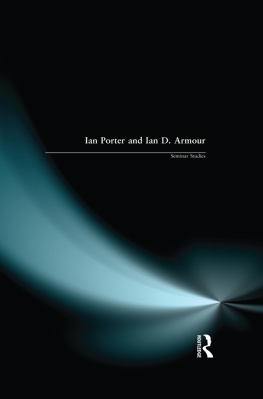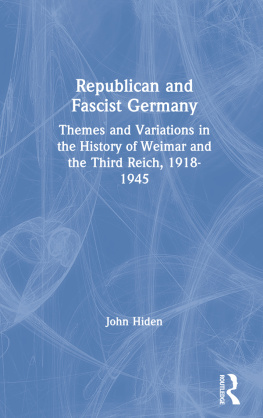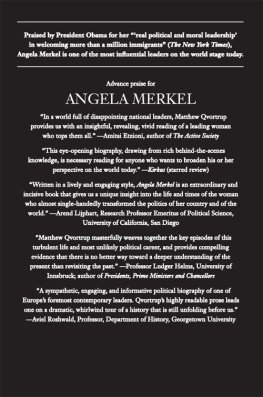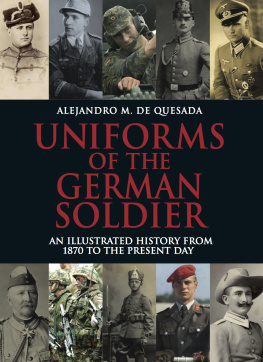
CONTENTS
List of Illustrations
- Chapter 02
- Chapter 03
- Chapter 04
- Chapter 05
- Chapter 06
- Chapter 07
- Chapter 08
- Chapter 12
- Chapter 13
- Chapter 14
Guide
Pages
A History of Germany 19182014
The Divided Nation
Fourth Edition
Mary Fulbrook
This edition first published 2015
2015 John Wiley & Sons, Ltd
Edition history: Fontana Ltd (1e, 1991), Blackwell Publishing Ltd (2e, 2002), Mary Fulbrook (3e, 2009)
Registered Office
John Wiley & Sons, Ltd, The Atrium, Southern Gate, Chichester, West Sussex,
PO19 8SQ, UK
Editorial Offices
350 Main Street, Malden, MA 02148-5020, USA
9600 Garsington Road, Oxford, OX4 2DQ, UK
The Atrium, Southern Gate, Chichester, West Sussex, PO19 8SQ, UK
For details of our global editorial offices, for customer services, and for information about how to apply for permission to reuse the copyright material in this book please see our website at www.wiley.com/wiley-blackwell.
The right of Mary Fulbrook to be identified as the author of this work has been asserted in accordance with the UK Copyright, Designs and Patents Act 1988.
All rights reserved. No part of this publication may be reproduced, stored in a retrieval system, or transmitted, in any form or by any means, electronic, mechanical, photocopying, recording or otherwise, except as permitted by the UK Copyright, Designs and Patents Act 1988, without the prior permission of the publisher.
Wiley also publishes its books in a variety of electronic formats. Some content that appears in print may not be available in electronic books.
Designations used by companies to distinguish their products are often claimed as trademarks. All brand names and product names used in this book are trade names, service marks, trademarks or registered trademarks of their respective owners. The publisher is not associated with any product or vendor mentioned in this book.
Limit of Liability/Disclaimer of Warranty: While the publisher and author have used their best efforts in preparing this book, they make no representations or warranties with respect to the accuracy or completeness of the contents of this book and specifically disclaim any implied warranties of merchantability or fitness for a particular purpose. It is sold on the understanding that the publisher is not engaged in rendering professional services and neither the publisher nor the author shall be liable for damages arising herefrom. If professional advice or other expert assistance is required, the services of a competent professional should be sought.
Library of Congress Cataloging-in-Publication data is available for this book.
ISBN 9781118776148 (Paperback)
A catalogue record for this book is available from the British Library.
Cover image: Berlin Wall Photocase Addicts GmbH / Alamy
Plates
| Unemployed dock-workers in January 1931 |
| Hitlers triumphal arrival to popular acclaim in his former home town of Linz during the 1938 Anschluss of Austria (which subsequently represented itself as Hitlers first victim) |
| German soldiers execute partisans, Lithuania, 1944 |
| Jews in the Warsaw Ghetto, who, if they survived the misery, hunger and sickness of ghetto life, would ultimately be transported and murdered in an extermination camp |
| West German Chancellor Konrad Adenauer looks uncomfortable on a visit to Berlins Brandenburg Gate, in August 1961, a week after the Berlin Wall was erected |
| Schoolchildren on their weekly day in industry in the peoples own factory, with which their school is twinned, admire the progress board in the competition for fulfilment of the plan |
| Couple watching television, Er magazine cover, 1952 |
| East Berliners hack out mementoes from the now defunct Berlin Wall, in the spring of 1990 |
| Demonstration against rising rents and gentrification, Kreuzberg, Berlin, June 2013 |
| CDU poster Wir haben mehr zu bieten (We have more to offer) showing CDU candidates Vera Lengsfeld (formerly Vera Wollenberger) and Angela Merkel |
| Stolpersteine pavement cobblestones to stumble over, commemorating former Jewish inhabitants who were deported and murdered by the Nazis |
| The Memorial to the Murdered Jews of Europe, in the heart of Berlin, spreading over several acres between the Brandenburg Gate and the site of Hitlers bunker, and providing an inescapable and controversial reminder of the Jewish victims of Nazism |
Maps
| The Versailles settlement, 1919 |
| The electoral performance of the NSDAP, 19241932 |
| The Reichstag elections, 5 March 1933 |
| Territorial annexation, 19351939 |
| The partition of Poland, 1939 |
| Hitlers empire by autumn 1942 |
| Major concentration camps, including extermination centres |
| Proportions of Europes Jewish population murdered in the Final Solution |
| The division of Germany after 1945 |
| United Germany, 1990 |
Preface to the Fourth Edition
The fourth edition includes substantially updated material for on the Berlin Republic, as well as a number of amendments throughout the text, reflecting the changing emphases of the historiography over recent years. I have again decided against major restructuring and rewriting, although in many areas, if I were to start afresh, it would be a substantially different book. I would like in particular to thank the following for their helpful written comments on the previous edition, particularly relating to references to Poland throughout the work: Professor Daria Nacz of the Polish Academy of Sciences, Lazarski University; Professor Marek Wierzbicki of the Catholic University of Lublin; and Marcin Wodziski of the University of Wrocaw; as well as other participants in a meeting on Recovering Forgotten History which took place in Warsaw in 2011. I would also like to thank the anonymous readers for Blackwell for their various suggestions regarding the whole text, and Carl for his characteristically perceptive and intelligent comments on aspects of Weimar culture.
Preface to the Third Edition
In making revisions for the third edition, I have added a separate chapter on Germany since unification, andhavesubstantially up dated the bibliography. In some sections of the book, I have also amended the text where I felt that there were significant omissions, or where the historiography has moved on so much that my previous remarks could not be left untouched. In making revisions, however, I have again had to resist the temptation to write a substantially new book, and have left the original lines of argument and organization intact.
Preface to the Second Edition
Revising this work for a second edition, ten years after its first appearance, has proved an interesting experience. I first completed the original manuscript as the GDR was in the process of implosion and collapse; I hung onto the manuscript, writing the chapter on the revolution and unification as events actually unfolded in the course of 198990. Not only was there no secondary literature at this time on the immediate events of 198990; there was also remarkably little of any depth on the longer course of GDR history, polarized as this field was between state-sanctioned MarxistLeninist accounts in the East and a predominance of rather narrowly institutional, occasionally speculative political science analyses in the West, alongside dissident critiques and ambiguous literary interpretations. With the opening of the East German archives in the early 1990s this situation has now radically changed. There is a flourishing field of GDR historical research, with the emergence of whole new areas of inquiry, lively debates and conflicting interpretations. Meanwhile, research on the Third Reich has also moved on significantly, although perhaps given the scale of what was already happening in this most controversial field before 1990 proportionately less dramatically. While there have also been shifts of emphasis in the fields of the Weimar Republic and pre-1990 West German history, particularly in areas of social history and in studies seeking to cross the 1945 divide, these have perhaps not produced such a radically new intellectual landscape on the scale of that for the GDR.
Next page








